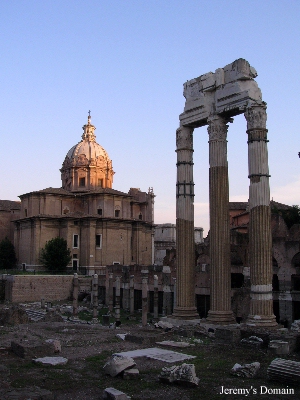 |
Roman Forum- central area around which ancient Rome developed. |
It's been more than a month since I first stepped foot in Rome, the eternal city. However, it still feels like it was only yesterday that I was walking down the banks of the Tibur River, running up and down Via Cavour (which by the way is found in every Italian city I went to), being awestruck by all the amazing architecture and artwork, and walking through the ruins and trying to connect with the past. I guess Rome is not a place that you forget easily. Not surprising as the city is in fact considered a sort of living encyclopedia of the last 3000 years of western art.
Well, let the recollection begin. My initial plan was to head towards northwestern China to explore part of the Silk Road. Then, I heard that some of my university friends were planning a performance for a festival in Italy. Of course that piqued my interest and somehow I got myself into the group. Finally, on 22nd June, Serene, Prema and I set off for Italy.
It wasn't a direct flight. After about six hours, we landed in Dubai. From the plane, I could see how dry Dubai was. There was hardly any greenery, and where there were, they appeared to be planted, rather than growing naturally. Anyway, the airport terminal itself is ultra modern, though I think it looks a bit tacky with its fake palm trees and Arabian night styled panels on the walls. There's a nice duty-free shop where you can grab some souvenirs though.
Flying out of Dubai Airport, I caught sight of one of Dubai's palm-shaped islands. Looks really nice and impressive. As we flew over the Sinai Peninsular, I saw endless stretches of desert, and there wasn't a cloud in the sky to obscure our view. I can't even begin to imagine how hot it is down there. Well, maybe hot is an understatement. Soon, we flew over the Suez Canal. It looks really nice from the sky. Imagine the blue waters of the canal snaking its way through the desert. It's really hard to describe. I just hope your imagination is good enough. :)
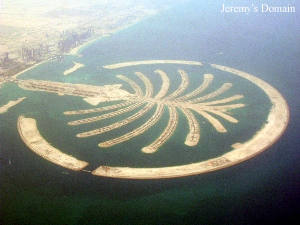 |
One of the Palm Islands in Dubai. |
Soon after, we arrived at Fiumicino Airport in Rome (also known as Leonardo da Vinci International Airport). The airport terminal itself is pretty spartan and boring. After collecting our luggage, we headed to the subway. Well apparently there are two types of train you can take to the historic centre of Rome- the express train and the metropolitan train. We chose the cheaper option- the metropolitan train (treno ordinario) which cost only €5. However, it doesn't bring us all the way to Stazione Termini, the main train station in Rome. We had to make a transfer midway to the Rome Metro which cost us €1. Soon after, we arrived at the Termini Station.
We decided to head to our hostel, Casa Olmata to offload our baggage before we explored Rome. Lo and behold, the hostel was closed. We had arrived during their lock-out hours. Well, it's either we wait outside their hostel, or we explore its vicinity. We chose the latter option. Weighed down by our backpacks, we walked towards the Basilica di Santa Maggiore (Saint Mary Major Basilica). Well at that time we didn't know its significance, but we were amazed at its beauty.
The church is considered by many to be the most beautiful church in Rome after St. Peter's Basilica and it's not hard to see why. The basilica is rich in works of art and the artwork covers every nook and cranny of the church. Makes your head spin with all its beauty. You literally do not know where to look. Built over the pagan temple of Cybele, Basilica di Santa Maria Maggiore is the only Roman basilica that retained the core of its original structure, left intact despite several additional construction projects and damage from the earthquake of 1348. It is also one of five churches considered to be the great ancient basilicas of Rome. Currently, it is the largest and most important place of prayer dedicated to the Blessed Virgin Mary.
Soon it was time to head back to our hostel to check in. To our horror, the person in charge told us that we couldn't have our beds because the minimum stay was for two days and we were only staying for one night. Fortunately, she made some calls for us and got us an alternative lodging at Roma Inn Youth Hostel, which is just a short walk away. Roma Inn itself was situated along some back alley and there are no signboards or stuff to signify its presence. Instead, we had to look for the unit number. Finally we found it. Roma Inn does not occupy the entire building so we entered the dark interior of the building, and headed to the second storey, which is where Roma Inn is sited. It's front desk is just one small counter in what appears to be the living room of a flat, but the lady manning the desk was quite friendly. We paid €20 each for a bed in the 8-person dormitory. The dormitory itself is very cramped and you hardly had any room to maneuver, but well, we didn't think so much about it. It was already 4 plus in the afternoon and we wanted to explore Rome.
From Roma Inn, we decided to head towards the Coliseum. Roma Inn's location was quite good as it was close to most of the major attractions in Rome. After taking a couple of wrong turns, we finally caught sight of the world-famous Coliseum. Of course we couldn't bypass the opportunity to take pictures of this great historical monument. Meanwhile those who've watched the Hollywood movie Gladiator, would probably know this. The Coliseum, built between AD 72 and AD 90, is an amphitheatre that was once used for gladiator combat. It is capable of seating 50,000 spectators.
We paid €10 for entry to the Coliseum and nearby Palatine Hill. Walking in , we emerged from one the the 80 entrances at ground level into the arena. Underneath the arena in the centre of the Coliseum was the hypogeum (literally, "underground"), a network of tunnels and cages where gladiators and animals were held before contests began. There were also numerous trap doors in the arena floor for the various animals hidden underneath. The arena floor no longer exists, and the hypogeum walls and corridors are clearly visible in the ruins of the building. (You can see it in the picture below)
As we only had an hour before closing time, we walked around quickly to explore the place. It feels quite surreal being here, especially with all the birds flying overhead. The place is infested with tour guides and tourists (then again, which place in Rome isn't), but still, it's possible to find a quiet corner to take in everything and be awed by the fact that we're in a place of such historical value and touching stones that were laid such a long time ago. We had barely just begun exploring the second level before we were shooed away from the site by a lady worker who told us that it's closing time.
 |
Inside the Coliseum which was built a mind-boggling 2000 years ago. |
Well, she didn't allow us even a second longer to linger there and chased us away from the Coliseum. Outside the Coliseum, we saw the Arch of Constantine. It was completed in 315 to commemorate Constantine the Great’s victory over an Italian rival, which made Constantine the absolute monarch of the Roman Empire. Constantine the Great was the first Roman ruler to become a Christian, and under his rule Christians were able to worship freely.
From here, we walked on to the Roman Forum. It's just a short walk away. The Forum was the central area around which ancient Rome developed, in which commerce, business, trading and the administration of justice took place, so most of the historical sites are around the Forum. Today, it's all in ruins, but think of how impressive it must have been in its heyday. Soon we ended up at the Monument of Victor Emmanuel II, which was erected between 1895 and 1911 to honour Victor Emmanuel, the first king of unified Italy.
The building is built of pure white marble (which isn't so white now after suffering from the effects of pollution), and has majestic stairways, fountains and statues. It was closed when we were there but we'll back back in less than two week's time. More on that later. The monument is controversial. Its construction destroyed a large area of Capitoline Hill housing a medieval neighbourhood. The building itself is often regarded as pompous and too large. Nonetheless, in the setting sun, it looked, well, impressive and definitely worthy of a couple of snapshots.
Just across the road, we stopped for dinner at a cafe. The pizzas were pretty cheap but we made a big mistake of ordering mineral water. It cost more than our meal. By the way, the sparkling type of mineral water is pretty popular in Italy and if you want to avoid it, look out for water bearing the naturale sign and avoid those saying frizzante. After dinner, it was pretty late already. We decided to just make two more stops for the night.
First we headed to Trevi Fountain. It is the largest and most ambitious of the Baroque fountains of Rome. The fountain looked amazing but there was an amazingly large number of people there as well. If you've been reading all the guidebooks about Rome, you'll naturally be wary about large crowds because most of the guidebooks tell you to beware of pickpocket gangs operating in Rome. Anyway legend has it that if you toss a coin with your right hand over your right shoulder into the fountain, you'll be ensured of a return to Rome. We didn't manage to do that, though I do want to return to Rome someday. Well the legend only says that if you throw a coin in, you'll be ensured of coming back. It didn't say that if you don't toss a coin in, you won't return.
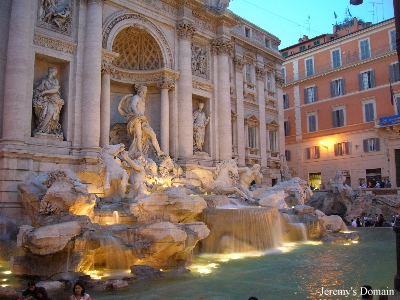 |
Trevi's Fountain- the most famous fountain in Rome. |
From Trevi Fountain, we walked on to the Spanish Steps. At the base of the steps is an early Baroque fountain called the Barcaccia (the ugly boat), though it didn't look ugly to me. The Spanish Steps is at the heart of Rome's most exclusive shopping district, but we didn't explore much of the district. Well, when you're a pauper, you won't really want to look at all the branded stuff. Anyway, the Spanish Steps is a popular meeting point and it was a hub of activity when we were there. Tourists taking pictures, locals chilling out, singing at the top of their lungs, etc. An interesting point to note is that eating is forbidden on the steps though I don't know whether the rule's actually enforced. We decided to go to the top of the steps. It's actually quite a good place to relax and hang out with friends. From here, we decided to head back towards our hostel. It's been a long day and we were all dead tired.
The next morning, we got up early to go to the Vatican City. Walking down Via Cavour, we ended up near the Roman Forum again. However, we did not stay long. We figured that we'll be able to explore the forums upon our return from Arezzo in less than two week's time. And so we walked on. After walking for some time, we finally caught sight of Castel Sant'Angelo, a strange, circular tank of a building which was on the right bank of the Tiber River. Built between 135 and 139AD, Castel Sant'Angel was originally meant as a mausoleum. Later it was converted into a fortress, then a noble dwelling and finally a papal residence; between times it served as a barracks and a prison. Today, it's a museum and we had to cross a beautiful bridge, Pont Sant'Angelo, to get there. The bridge, said by many to be one of the most beautiful in the world, is lined with statues of angels.
After deciding not to pay to enter the museum, we headed towards the Vatican City. It's only a short walk from here. In fact, we could already see St. Peter's Square and Basilica. Soon we arrived at St. Peter's Square. It was an impressive sight. The classical style of the piazza is expressed in the colossal Doric colonnades, four columns deep, which frame the trapezoidal entrance to the basilica and the massive oval area which precedes it. At the centre of the oval is a 13th century BC Egyptian obelisk which was moved to Rome in the 1st century. We proceeded to the right side of the Square to join the long queue to enter Vatican City. At the border, we had to pass through the usual border checks- X-ray machines, security guards, etc. By entering the Vatican City, we were actually leaving Italy. This is because the Vatican City is the smallest independent nation state in the world. However, there was no need for passports.
Upon entering the Vatican, we kept to the right and joined the queue to enter the Vatican Grottoes, a crypt under St. Peter's Basilica known as the Tomb of the Popes. Before entering the crypt, there's a fountain where you can fill up your bottles with the cool, refreshing water. Having had our fill of the cool water, we entered the grottoes. Underground, we passed by the tombs of various Popes, but sad to say, I must admit I don't know half of who these people were. Within the grottoes, there were many security guards who made sure we did not wander where we were not supposed to. Soon, we arrived at the tomb of Pope John Paul II. He had passed away on the 2nd of April, just slightly more than two months ago. There were guards next to his tomb to tell people to move on because clearly his tomb was the one which attracted most attention. As a result, most people were unable to spend much time in front of his tomb. I barely had enough time to snap a picture and look around at his tomb before the ushers hurried me along. His tomb was very simply designed. He had requested that he not be placed in an elaborate sarcophagus and ornate aboveground tomb, as was done to his predecessors. Thus, there is only a white marble gravestone engraved with his Latin name "IOANNES PAULUS PPII", and the dates of his 26-year papacy.
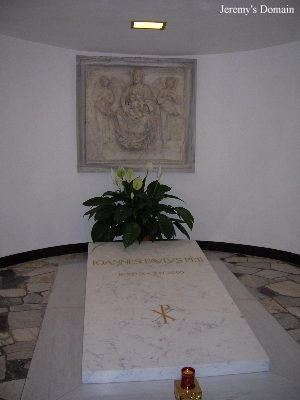 |
Tomb of the late Pope John Paul II in the grottoes of St. Peter's Basilica |
From the grottoes, we emerged into St. Peter's Basilica. We were awestruck. Such beauty. It was overwhelming. We didn't even know where to start looking. And it was huge. Possibly the largest church in Christianity, it covers an area of 23,000 m² and has a capacity of over 60,000 people. Now, there are several noteworthy monuments and memorials within the Basilica but I can't remember their names though they are all impressive. Right in the centre of the Basilica, underneath the dome stands the high or papal altar, commonly known as the Altar of the Confessio. It is surmounted by the splendid, majestic bronze "baldacchino", Gian Lorenzo Bernini's first work in the basilica. The tomb of St. Peter's in believed to be directly beneath it. After gawking at the magnificent structure for some time, we decided to start exploring the place. Soon we came across a Mass being held. Hymns were sung and prayers were recited. Somehow it feels a little surreal seeing this in one of the holiest sites of Christendom.
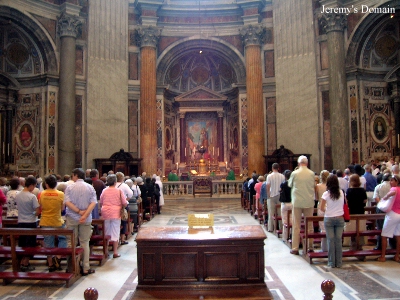 |
Mass inside St Peter's Basilica. |
Now, as I mentioned earlier, I can't really remember the names of what I saw (not that I knew them in the first place), so let me fast forward a bit. Next, Serene remembered that Michelangelo's famous sculpture Pietà, was found here, and so we went in search of it. Soon we found it. There were lots of people crowding around a bullet-proof glass. The Pietà was behind it. The protective glass panel was installed after a deranged Hungarian-born Australian damaged the statue with a hammer in 1972. After jostling with the crowd to get a good picture of the Pietà, we decided to head for the Sistine Chapel. Soon, we realized that we couldn't enter the Sistine Chapel from here. First we had to leave the Vatican City. Then we had to walk along the outer walls of the Vatican City to the Vatican Museums. It was a long and tiring walk. We had arrived in Italy during a heatwave and the sun's rays were unforgiving. After asking around for directions, we finally saw the entrance of the Musei Vaticani (Vatican Museums).
 |
Michelangelo's Pieta depicting the dead body of Jesus in the arms of his mother Mary. |
Somehow I had the impression that admission to the Sistine Chapel was free. I was wrong (well, on the day that we were there anyway). Entry to the museums, which includes the Sistine Chapel, were free only on the last Sunday of the month. Since it wasn't, we had to pay admission fees to enter. By producing our student passes, we qualified for the student price of €8 instead of €12. Now, the Vatican Museums was huge. It boasts one of the world's largest art collections. Since we didn't have a lot of time to spare, we decided to be selective in our choices of what to see. We decided to head towards the Sistine Chapel, the reason why we were here in the first place.
There was signs pointing in all directions and I can't remember how we made our choice, but anyway we started walking in one of the directions. The situation here is similar to that at St. Peter's Basilica. There's so much to see that I don't even know where to start. And as I'm writing this travelogue, I realize that because there's so much stuff to see (and partly because we rushed through the museum), I've also forgotten a lot of what I've seen. In a way, the exhibits and artwork are meant to be appreciated in person, and even though I may have forgotten where I saw what, I can still remember how I felt then. I was amazed by the amount of beauty that was in there. In a way, it was almost like sensory overload. The eyes were taking in so much that after a while, my brain stopped processing what I saw. Everything was so wonderful that after a while, I felt as if I was numb to the beauty around me. The amount of artwork in there is amazing, and I say this even though I've only seen like a fraction of what the museums have to offer. In fact, one could spend days in there just enjoying all that art.
Now, we had entered the Vatican Museums only because we wanted to visit the Sistine Chapel. However, on hindsight, I'm so glad that we decided to enter the museums. I loved the Vatican Museums, ever single moment of it and I only wished that I had more time to explore the place. Meanwhile, I suggest that you warm up your neck before entering the museums as a lot of time will be spent craning your neck, looking at the artwork on the ceilings.
I won't go into specific details of what I saw (not that I could anyway), but I'll paint a rough picture of what I enjoyed the most in the museums. The Gallery of Maps is gorgeous. Despite holding a guidebook, Prema told us that it's the Sistine Chapel and we believed it to be so. We didn't find out that it wasn't until much later when we were close to the 'real' Sistine Chapel. Anyway it was strange that we believed that it was the Sistine Chapel. First, it wasn't a chapel. Second, it didn't quite gel with the image of Sistine Chapel that we had gotten from books or TV. Nonetheless, I was very impressed with the Gallery of Maps. The ornate hallway was covered with large maps from periods in the Vatican's history. The ceilings were covered with frescoes and giving out a soft golden glow. You can't help but be taken in by the grandeur of the hall.
After exiting the Gallery of Maps, we passed rooms filled with statues, tapestries, paintings, etc. Some of the rooms were extremely dark. I guess it must have been to protect the artwork in those rooms. After passing countless rooms, we finally reached the Sistine Chapel. Before entering the church, we saw a sign that says no photography and filming allowed. Within the church, there're actually guards in there to make sure that no one takes pictures or starts filming. They also ensure that no one sits down on the stairs as well. Anyway, I was slightly disappointed when I first saw the place. Especially since I've heard so much about it. Well, part of the reason is that the lighting in the place is so dim. It was illuminated solely by the light coming from the windows at the top. Also, I can't help comparing it with the grandeur of the Gallery of Maps. However, after sitting down and looking up at the ceiling for some time, I noticed that the painting appears to be popping out. It looks really three-dimensional. And yet when I checked from the side, the ceiling's flat. That's when I realized that all the hype over the church wasn't for nothing. It really is an amazing piece of artwork.
 |
Sistine Chapel. |
The collection in the museums are very extensive. As such, we took quite some time going through all the rooms even though we rushed through them because we were running out of time. Eventually we made our way to a cafeteria within the museums. There I had my first pizza in Italy. In my famished state, it tasted pretty good.
After resting a while, we decided to make our way out of the museums. Just before exiting the museums, we came across a very interesting double spiral staircase. Unfortunately I realized this only after I came home and read something about this staircase. Apparently, while it looks like one continuous spiral staircase, there're actually two separate staircase. I still can't figure out how it works. Anyway, from the museums, we made our way to the metro station and boarded the train to Colosseo, which is in front of the Coliseum. We were supposed to meet Mel and Sam there. But they're still within the Coliseum. Thus, we decided to make use of our ticket to enter Palatine Hill (our admission fees to the Coliseum includes entry to Palatine Hill).
Palatine Hill is the centermost of the legendary seven hills on which Rome was founded. It's also one of the most ancient parts of the city. Apparently Rome has its origins in Palatine Hill and people have lived here since approximately 1000 BC. Of course it's all in ruins now. With not much time to spare, we decided to do a fast-forward tour of the place. The entrance was near the Arch of Titus. On Palatine Hill, we saw mostly ruins of palaces and homes of the rich. With not a lot of background knowledge of the place, it wasn't very interesting. Somehow I thought that the famous Etruscan bronze statue of the She-wolf suckling Romulus and Remus was found here and so we went around asking people. Finally one guy told us that it was in Capitoline Hill. Well, no chance of seeing it then. Very soon, it was time to meet Sam and Mel before meeting the rest at Termini. We sped down Palatine Hill to meet Sam and Mel in front of the Coliseum. They were already there.
It was too late to do any more sightseeing. They decided to go to Termini Station to meet the rest while we pick up our luggage from our hostel. After picking up our bags from the hostel, we made our way to Termini, a huge train station that's reputedly the haunt of pickpockets. As a result, we were extremely cautious and fortunately, nothing happened to us. At Termini, we met up with the rest, got our tickets and boarded the train to Arezzo.
Ten days later, we were back in Termini Station. We had taken the early morning train from Arezzo. As we had to board the Terravision shuttle bus to the airport early next morning, we decided to find the boarding location first. Easy enough, it was just outside Termini. With that settled, we made our way to our hostel, Pensione Kenzo. It wasn't easy locating it. It was located within a nondescript building with no signs to indicate that it was in there. All we had was the block number, and we had to go door to door within the building to find it. Finally we found it. Alas, the boss wasn't around, so we couldn't check-in. After waiting some time, the boss called and told us that he had alternative lodging for us. He claimed that it's better than the place we were at. Since we wanted to quickly put down our bags and start exploring Rome, we agreed to follow him. He drove us to another building that's very near Termini. Great! We put down our bags and left the building in double quick time.
After grabbing some food and sitting by the roadside to eat it, we started walking around. Eventually we ended up at the 4th-Century Baths of Diocletian. It was the largest and most sumptuous of the imperial baths and remained in use until the aqueducts that fed them were cut by the Goths in 537. Today there's a museum within it, the Museo Nazionale Romano as well as the Basilica di Santa Maria degli Angeli e dei Martiri. Look out for an interesting exhibit outlining the history of the building's transformation from baths into a church. Michelangelo had worked up to 1561 to adapt the baths to a church. Most guidebooks don't mention this place but I think it's well worth a visit. The church was the official state church during the Kingdom of Italy. There're lots of paintings in there and the interior is really nice. There's also a 45m long sundial on the floor that's used to predict Easters. The exterior is interesting as well as it shows the partially preserved outer walls of the Baths of Diocletian.
 |
Santa Maria degli Angeli
e dei Martiri is a basilica built inside the ruins of the baths of
Diocletian |
In front of the Basilica di Santa Maria degli Angeli e dei Martiri is the Fontana delle Naiadi. It's said to be the most beautiful of the modern Roman fountains. From here, we walked down Via Nazionale towards the Roman Forum. It was a long walk and the heat was really getting to us. Apparently the heatwave hasn't subsided. Finally we reached the imposing Monument of Victor Emmanuel II. It had been closed when we were here before, but today there's some ceremony going on on the steps and people were walking into the building. We decided to follow them up the majestic stairway.
Inside the building, we realized that the building also holds the Tomb of the Unknown Soldier as well as the Museum of Italian Reunification. We decided to take a look at the museum. It contains mostly historical military artifacts and I think Prema was bored out of her wits here. For me, while it wasn't exactly fascinating, there were a couple of exhibits which I felt were interesting, such as the weapons and uniforms they used in the past. There were also lots of busts of the various Italian leaders, but try as we might, Serene and I couldn't find Mussolini's bust. I guess the honour is only bestowed on certain leaders and certainly not someone as controversial as Mussolini. Suddenly I'm reminded of that famous quote from the movie Gladiator- "What we do in life, echoes in eternity". Well, upon exiting the museum, we came to this open-air terrace at the top which had a great view of the Roman Forum. You can even see the Coliseum from here. This is definitely a must-see.
From the Monument of Victor Emmanuel II, we walked over to the Pantheon. It was originally a Roman temple dedicated to the seven deities of the seven planets in the Roman state religion. In the Middle Ages it was consecrated as a church and that probably saved it from being abandoned and ending up in ruins. Today it's still a church and it's one of the best preserved historical sites in Rome. It's also one of the most-visited sites in Rome. As a result, there're fake Roman guards and touts selling fake branded goods in front of the Pantheon, hoping to entice you to part with your money. We ignored them and headed straight into the Pantheon. By now, we had gotten used to the fact that the interior of most churches in Rome were splendid and magnificent. This was no exception. The interior is decorated with colored marble, and lined with columns and beautiful paintings.
The unique thing about the Pantheon is the oculus in its dome. There was no glass or any form of covering over the oculus and I suppose when it rains, the rain will come through the opening. Fortunately it was bright and sunny when we were there. Anyway, back to the dome. It's the largest dome in Western Europe until the Duomo in Florence was completed. The construction of the dome was one of the most impressive engineering feats in its time. It's even more amazing considering that even today if you build a dome in these proportions using modern concrete, the dome would hardly stand the load of its own weight, since concrete has very low tensile strength. And yet the Pantheon has stood for nearly 2,000 years! You gotta take your hats off to these ancient Romans. We looked around the Pantheon for a while more, before we finally left the place.
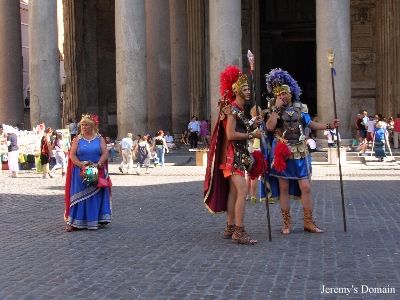 |
Fake guards in period costumes in front of the Pantheon. |
By then, it was already getting late. We deliberated on whether to go to the Roman Forum, Trastevere or just wander around the immediate vicinity of the Pantheon. Eventually we chose the last option. After deciding not to use the map, we started walking around. We entered two lovely churches around the area (though I've no idea what churches they were) and then we walked on and on. Finally, we decided that we're lost. Looking at the map, we figured that we're pretty close to the Vatican City, and so we headed in that direction. Soon, we crossed the Bridge of Angels over the Tiber River and ended up near Castel Sant'Angelo. By then we were all tired out from the day's activities and we decided to sit down and chill as the sun sets over the eternal city.
As twilight approaches, the lights in the Vatican City start coming on and it was a beautiful sight. Of course we couldn't let this moment go by without snapping some pictures. Soon, it was time to go. We had to catch some sleep before boarding the 6am flight the next day. We walked back along the Tiber River. Below us, stretches of sand and synthetic grass have been trucked in to form an artificial beach along the banks of the river. Meanwhile, loud music was blaring out of the bars and restaurants and people were dancing. It was really a party atmosphere. Later on, as I searched through the internet, I realized that this 600 foot long stretch of artificial beach was created as part of efforts to bring people back to the river, and this artificial beach will remain there for three months, till mid-September.
We continued walking. We're trying to head for the nearest Metro station. It was the Spagna station beside the Spanish Steps. We decided to head there. Soon, we reached the Piazza di Spagna where the Spanish Steps were. As before, it was a hive of activity. Lots of people were sitting on the steps, people were singing at the top of their lungs, tourists were snapping pictures and we were hurrying to the metro station, but not before grabbing some grub from a hole-in-the-wall eatery just beside the station. After we entered the station, we realized to our dismay that the station was closed. After going through our options, we decided to walk back. It was a long walk. Back at the hostel, we lost no time in packing our luggage, washing up and getting to bed.
Barely two hours later at around 4am, we woke up to head towards Termini Station to board the bus that will take us to Ciampino Airport. Soon, we were on our way to the airport. It was a short ride. The airport terminal itself is small and nondescript. Despite it being only 5am, there was already a large crowd in there waiting to check-in. We found our counter and proceeded to check-in. After checking-in, we went to the departure area and bought some food. Soon it was time to part ways with Serene. She was going to London, while me and Prema were going to Paris. Suddenly, all the people stood up and rushed towards the doors. It was time to board the Ryanair flight. As it was free-seating, everybody was rushing to the front to ensure that they got good seats. After queuing up for a long time, we finally got on the shuttle bus that brought us to the plane. But the story doesn't end there. After all the passengers were seated in the plane, the pilot announced that one of the stewardess was caught in a traffic jam. Therefore, our flight would be delayed while we waited for her. How exciting! Anyway I don't really know what happened after that as I fell asleep, but eventually after about an hour, our plane finally took off. If you happen to be taking a flight from Rome to Paris, do keep your eyes peeled for the Italian Alps. It's a very beautiful sight.
About two hours later, we arrived in Paris. But well, that's another story.